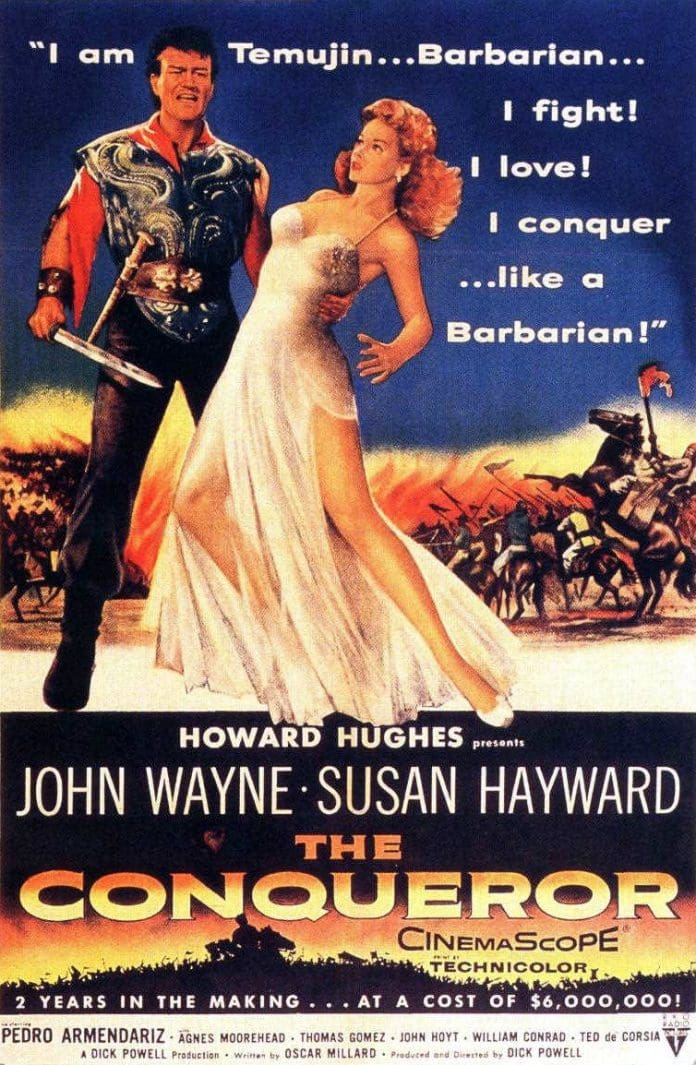In the pantheon of Hollywood misfires, few films loom larger or cast a darker shadow than The Conqueror. Released in 1956, the film is infamous for two deeply troubling legacies: its egregiously racist miscasting and orientalist portrayal of Mongol culture, and its association with a disturbingly high number of cancer diagnoses and deaths linked to nuclear fallout at its filming location. What began as a vanity project bankrolled by eccentric billionaire Howard Hughes ended in a bizarre and tragic story of cultural insensitivity and radioactive exposure, one of the film industry’s most harrowing cautionary tales.
Racial Miscasting and Yellowface in Mid-Century Hollywood
At the centre of The Conqueror’s controversy lies its whitewashing of Genghis Khan. In a spectacularly misguided casting decision, John Wayne—then the archetype of American masculinity, a tall, broad-shouldered cowboy with a slow Western drawl—was chosen to play the Mongolian emperor. His speech, mannerisms, and appearance bore no resemblance to the historical figure he was portraying. To make matters worse, Wayne was fitted with prosthetic eyelids, heavy eyeliner, and bronzer to simulate “Asian” features, a crude and racially insensitive practice known as yellowface.
John Wayne was not alone. Nearly the entire main cast consisted of white or Latino actors wearing make-up and costumes designed to “exoticise” their appearance. Susan Hayward (as Bortai), Agnes Moorehead (as Hunlun), and Pedro Armendáriz (as Jamuga) were all made to appear Mongolian through similarly offensive and inauthentic styling. The cast spoke in stilted, quasi-archaic English while spouting lines filled with orientalist clichés. The characterisations were wooden, the accents absurd.
Hollywood’s practice of casting white actors in non-white roles was not uncommon at the time, but The Conqueror was a particularly flagrant example. The film failed to include a single Central or East Asian actor in a leading or even supporting role, despite its Mongol subject matter. Asian-American actors, already marginalised by the industry, were largely shut out of such productions—relegated to background roles if included at all.
The screenplay, penned by Oscar, contributed further to the problem. It romanticised and distorted Mongol history, presenting Genghis Khan not as a complex historical leader but as a brutish, hypersexualised conqueror whose primary goal seemed to be the subjugation of women. Hayward’s character, Bortai, is abducted and forcibly made the Khan’s bride in a plotline that reflects 1950s Hollywood’s toxic views on race, gender, and power.
Even by the standards of its day, critics were alarmed. The New York Times review described the film as “ludicrous”, with Wayne’s performance “an affront both to acting and history.” Over the decades, The Conqueror has become a case study in Hollywood racism, used in film studies courses as an example of the industry’s systemic erasure and misrepresentation of Asian identities.
A Radioactive Set: Filming in Fallout Country
If its racism condemned The Conqueror creatively and morally, its production location may have doomed it physically.
In 1954, principal photography was conducted near St. George, Utah, a picturesque area surrounded by red rock canyons. What the filmmakers did not fully grasp, or chose to ignore, was that St. George lay directly downwind of the Nevada Test Site, where the United States had been conducting above-ground nuclear tests under Operation Upshot–Knothole. Between 1951 and 1953, eleven large-scale nuclear detonations had taken place just 137 miles away.
Although the Atomic Energy Commission publicly claimed the area was safe, residents of St. George had already begun experiencing health problems. Cattle were being born with deformities. Local citizens were reporting unusual illnesses. Yet the Hollywood crew pressed on, bringing over 220 actors, technicians, and support staff into an irradiated zone. Some accounts claim that Geiger counters brought to the set registered alarming readings—but were dismissed.
As if that weren’t reckless enough, Howard Hughes later ordered 60 tonnes of Utah desert soil to be shipped back to RKO Studios in Hollywood for reshoots—further exposing the cast and crew to radioactive material in a closed environment.
A Catalogue of Cancer: The Human Cost
By the 1980s, the full scale of the human toll became apparent. Of the approximately 220 cast and crew, at least 91 had developed cancer, and 46 had died from it; more than 40%, far exceeding the national average. Though direct causation cannot be proved, the correlation is chilling.
Key Figures Affected:
- John Wayne (Genghis Khan): Diagnosed with lung cancer in 1964 (from which he recovered after surgery) and later died of stomach cancer in 1979. Though a lifelong smoker, Wayne reportedly acknowledged the strange number of cancer cases among The Conqueror’s cast.
- Susan Hayward (Bortai): Died of brain cancer in 1975, aged just 57. She had no known family history of the disease.
- Agnes Moorehead (Hunlun): Died of uterine cancer in 1974. She later expressed concern about the film’s shooting location, calling it “cursed.”
- Pedro Armendáriz (Jamuga): Diagnosed with terminal kidney cancer in 1960. Facing a grim prognosis, he took his own life in 1963 at the age of 51.
- Dick Powell (Director): Died in 1963 from lymphatic cancer. He had been healthy prior to the film’s production.
- Lee Van Cleef, William Conrad, Thomas Gomez, and several lesser-known crew members also died from various cancers over the following decades.
Though some were smokers or had other risk factors, epidemiologists have long pointed out the statistical improbability of so many cancer cases arising from a single film shoot. Dr Robert Pendleton, a radiation scientist at the University of Utah, remarked:
“With these numbers, this case would qualify as an epidemic. The logical conclusion is that radiation caused it.”
Howard Hughes and the Suppression of a Film
Howard Hughes, increasingly reclusive and erratic in his later years, was reportedly haunted by guilt over The Conqueror. Disturbed by the rising cancer toll, he spent over $12 million acquiring all known prints of the film, attempting to prevent it from ever being seen again. He kept it out of circulation for nearly two decades until after his death in 1976.
The film was eventually re-released on television in 1974 and has since become a kind of cinematic ghost—often screened not for entertainment, but as a warning.
A Tragic Symbol
The Conqueror endures not merely as a failed Hollywood epic but as a symbol of institutional failure on multiple fronts: racial injustice, disregard for human life, Cold War secrecy, and artistic vanity. Its legacy is one of preventable suffering, of actors, extras, and workers who unknowingly paid the price for a studio’s ambition and a government’s negligence.
It is a reminder that history’s worst film disasters are not always measured in box office losses or poor reviews, but in lives lost.







